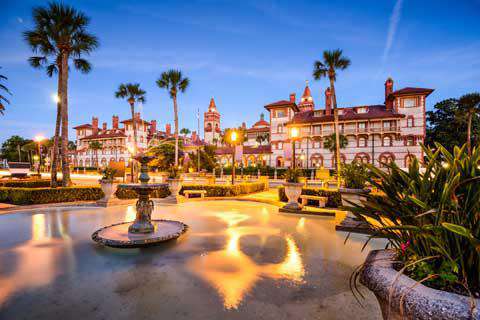How much does it cost to travel to Saint Augustine?
You should plan to spend around $159 per day on your vacation in Saint Augustine. This is the average daily price based on the expenses of other visitors.
Past travelers have spent, on average for one day:
- $49 on meals
- $39 on local transportation
- $172 on hotels
A one week trip to Saint Augustine for two people costs, on average, $2,230. This includes accommodation, food, local transportation, and sightseeing.
All of these average travel prices have been collected from other travelers to help you plan your own travel budget.
Independent Travel
Traveling Independently to Saint Augustine has many benefits including affordabilty, freedom, flexibility, and the opportunity to control your own experiences.
All of the travel costs below are based on the experiences of other independent travelers.
Is Saint Augustine expensive to visit?
Prices in Saint Augustine are reasonable and comparable to your average travel destination. Hotels, food, and sightseeing are generally within normal price ranges.
Within North America, which is known to be an expensive region, Saint Augustine is a moderately priced destination compared to other places. The overall cost of travel here is fair for the region and comparable to Newport or Savannah.
For more details, and to find out if it's within your travel budget, see Is Saint Augustine Expensive?
How much money do I need for a trip to Saint Augustine?
The average Saint Augustine trip cost is broken down by category here for independent travelers. All of these Saint Augustine travel prices are calculated from the budgets of real travelers.
|
Category
|
Cost
|
|
Accommodation 1
(Double Occupancy)
|
$172
|
|
Local Transportation 1
|
$39
|
|
Food 2
|
$49
|
|
Entertainment 1
|
$18
|
|
Alcohol 2
|
$12 -
37
|
Accommodation Budget in Saint Augustine
Calculated from travelers like you
The average price paid for one person for accommodation in Saint Augustine is $86. For two people sharing a typical double-occupancy hotel room, the average price paid for a hotel room in Saint Augustine is $172. This cost is from the reported spending of actual travelers.
Looking for a hotel in Saint Augustine? Prices vary by location, date, season, and the level of luxury. See below for options.
Transportation Budget in Saint Augustine
Calculated from travelers like you
-
The cost of a taxi ride in Saint Augustine is significantly more than public transportation. On average, past travelers have spent $39 per person, per day, on local transportation in Saint Augustine.
-
Transportation1
Taxis, local buses, subway, etc.
$39
How much does it cost to go to Saint Augustine? Naturally, it depends on the dates. We recommend Kayak because they can find the best deals across all airlines.
The price of renting a car in Saint Augustine will depends on dates, the type of car, the location, and your age. We recommend Kayak because they can find the best deals across all car rental companies.
Food Budget in Saint Augustine
Calculated from travelers like you
-
While meal prices in Saint Augustine can vary, the average cost of food in Saint Augustine is $49 per day. Based on the spending habits of previous travelers, when dining out an average meal in Saint Augustine should cost around $20 per person. Breakfast prices are usually a little cheaper than lunch or dinner. The price of food in sit-down restaurants in Saint Augustine is often higher than fast food prices or street food prices.
-
Food2
Meals for one day
$49
Entertainment Budget in Saint Augustine
Calculated from travelers like you
-
Entertainment and activities in Saint Augustine typically cost an average of $18 per person, per day based on the spending of previous travelers. This includes fees paid for admission tickets to museums and attractions, day tours, and other sightseeing expenses.
-
Entertainment1
Entrance tickets, shows, etc.
$18
Alcohol Budget in Saint Augustine
Calculated from travelers like you
-
The average person spends about $25 on alcoholic beverages in Saint Augustine per day. The more you spend on alcohol, the more fun you might be having despite your higher budget.
-
Alcohol2
Drinks for one day
$25
Saint Augustine on a Budget
 St. Augustine, Florida
St. Augustine, Florida
St. Augustine is the oldest European-established settlement in the United States. Spanish explorer Juan Ponce de Leon landed nearby and claimed the land now known as Florida in the name of Spain in 1513. They had originally named the land La Florida, which means "Land of Flowers". The city was founded by Spanish explorer Pedro Menendez de Aviles in 1565. Sir Francis Drake and John Davis burnt the city to the ground in 1586 and 1665 respectively, but St. Augustine soon became strong enough to fend off such attacks. Florida was purchased by the United States from Spain in 1819; it seceded during the Civil War, during which St. Augustine was occupied by Union forces.
St. Augustine has a humid subtropical climate, with mild weather during winters and hot weather during summers. It is common for daily thunderstorms to erupt during a typical summer afternoon, due to the heating of the land and water, combined with extremely high humidity. Sometimes in the winter it can freeze, but rarely. Most rains come from June to September.
St. Augustine is located on a peninsula between two rivers, the San Sebastian and the Matanzas. Tourism forms the backbone of its economy, though a few industries also make a significant contribution to the city’s yearly revenue.
Sights
The oldest landmark in St. Augustine is the Castillo de San Marcos is also its second oldest masonry fort in the United States, after the Castillo San Felipe del Morro in San Juan, Puerto Rico. Viewed from the air, it is seen to have the shape of a square with an arrowhead at each corner. It was first built in 1672 at the orders of Governor Francisco de la Guerra de la Vega to fend off the English privateer Robert Searles, who had been raiding the surrounding settlement. Since 1924, the fort has been a national monument.
The Cathedral Basilica, the oldest church in the state, was first built in 1565, burnt several times and rebuilt in its present form in 1797. It was designated a National Historic Landmark in 1970. The clay roof tiles and curving bell gables are characteristic of Spanish mission architecture.
Other attractions and landmarks in the city range from historical to touristy, and include the Fountain of Youth, Fort Matanzas National Monument and Ripley’s Believe It or Not.
Neighborhoods
While most of the "tourist" sights and activities are in the central part of the historic district, St. Augustine includes a number of other vital neighborhoods. Crescent Beach, to the south, is a small community that stretches along a beautiful portion of the Florida coast. There is little economic development here, but people like to take part in boogie boarding, water boarding and other sea sports. Butler Beach figured prominently in black American history - it was named for a black businessman - and also has a park where many endangered species live. Other neighborhoods include City Center, College Park, Hilden and Moultrie Junction.
Activities
A variety of recreational activities take place in St. Augustine. There is Anastasia Watersports in the state park of the same name where visitors can rent a canoes, kayaks, pedal boats and sailboats. Guided tours are also conducted of the historic areas, including nightly walking tours and Flagley College Legacy.
Food and Dining
Restaurants of all kinds line the streets of St. Augustine. Casa Maya serves organic food (not "tex-mex") from the Yucatn peninsula, while Creekside Dinery features much local seafood. Those who like Asian or South African cuisine should check out the Old City House, and fans of European dishes will love Le Pavillion. Another great dining experience, Saltwater Cowboy, is in the midst of saltwater marshes!
Transportation
Tourists can get around the city on the Augustine City Bus, the Sunshine Bus or the Old Town Trolley, all of which conduct tours of St. Augustine. So do the horse drawn coaches and trams that operate around town.
Related:
Looking for a
party hostel in Hawaii or
Miami? Traveling alone to
LA or
New Orleans? Want a budget hostel in
NYC?
We've been gathering travel costs from tens of thousands of actual travelers since 2010, and we use the data to calculate average daily travel costs for destinations around the world. We also systematically analyze the prices of hotels, hostels, and tours from travel providers such as Kayak, HostelWorld, TourRadar, Viator, and others. This combination of expenses from actual travelers, combined with pricing data from major travel companies, gives us a uniqe insight into the overall cost of travel for thousands of cities in countries around the world. You can see more here: How it Works.
 St. Augustine, Florida
St. Augustine, Florida

 Budget Your Trip is all about finding out how much everything costs so that you can travel cheaper and longer. Created by avid travelers Laurie and Bryan, our goal is to help you plan your next trip on the right budget. With average daily travel costs that are calculated from the budgets of real travelers, plus an analysis of hotel and tour prices, you can find out how much money you need to plan your next adventure. We also have plenty of travel advice, accommodation reviews, and activity suggestions.
Budget Your Trip is all about finding out how much everything costs so that you can travel cheaper and longer. Created by avid travelers Laurie and Bryan, our goal is to help you plan your next trip on the right budget. With average daily travel costs that are calculated from the budgets of real travelers, plus an analysis of hotel and tour prices, you can find out how much money you need to plan your next adventure. We also have plenty of travel advice, accommodation reviews, and activity suggestions.